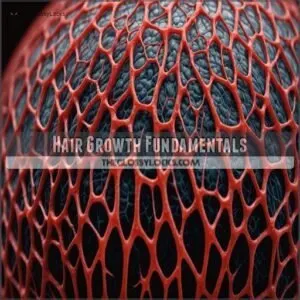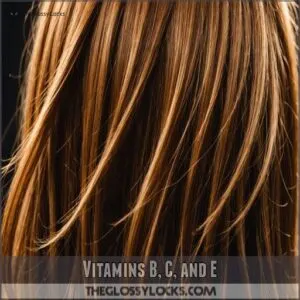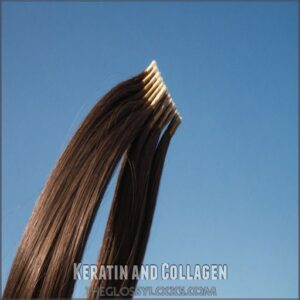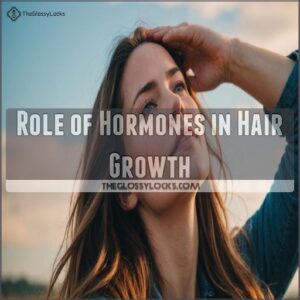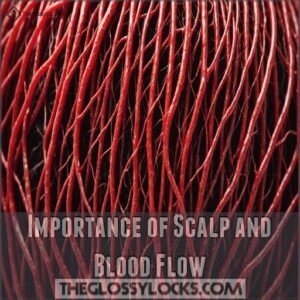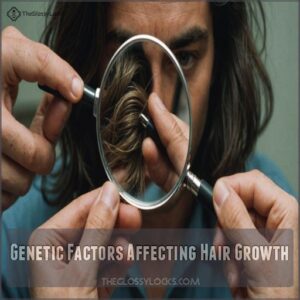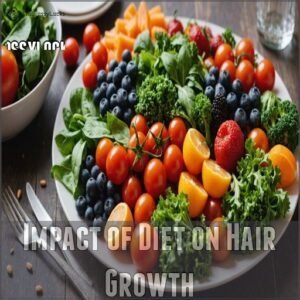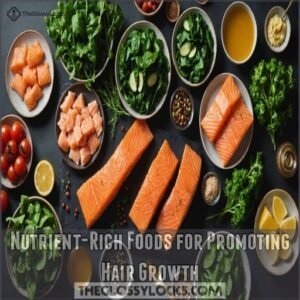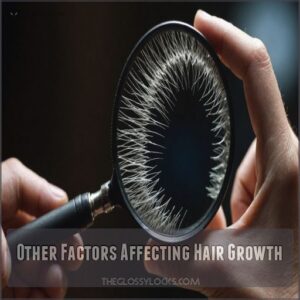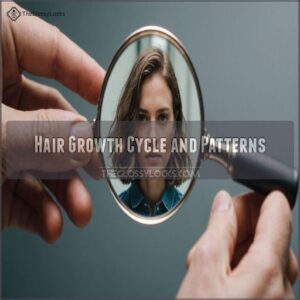This site is supported by our readers. We may earn a commission, at no cost to you, if you purchase through links.
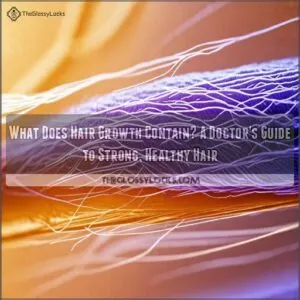 Your hair growth contains an intricate mix of proteins, vitamins, and minerals working together like a well-oiled machine.
Your hair growth contains an intricate mix of proteins, vitamins, and minerals working together like a well-oiled machine.
At its core, you’ll find keratin (that’s the protein that gives your locks their strength) and collagen, supported by essential B-vitamins, iron, and zinc.
Think of these nutrients as your hair’s building blocks – they’re constantly at work in your follicles, creating new strands from the inside out.
Biotin, vitamin D, and omega-3 fatty acids also play starring roles in this microscopic construction site.
Understanding these components is your first step to understanding the secrets of thicker, healthier hair growth.
Table Of Contents
- Key Takeaways
- Hair Growth Fundamentals
- Essential Nutrients for Hair Growth
- Key Ingredients for Hair Health
- Role of Hormones in Hair Growth
- Importance of Scalp and Blood Flow
- Genetic Factors Affecting Hair Growth
- Impact of Diet on Hair Growth
- Nutrient-Rich Foods for Promoting Hair Growth
- Other Factors Affecting Hair Growth
- Hair Growth Cycle and Patterns
- Frequently Asked Questions (FAQs)
- What foods help hair growth?
- How does food affect hair growth?
- What nutrients can help you grow your hair?
- How do you get hair growth?
- What is the main ingredient for hair growth?
- What actually causes hair to grow?
- What is in growth hair?
- What is hair growth determined by?
- How often should I cut my hair to promote growth?
- What is the role of collagen in hair growth?
- Do hair growth supplements interact with medications?
- Can stress levels affect the speed of hair growth?
- Does hair grow faster in certain weather conditions?
- Conclusion
Key Takeaways
- Your hair’s main building blocks are keratin and collagen proteins, which work with B-vitamins, iron, and zinc to create strong, healthy strands from the inside out.
- You’ll find three distinct growth phases in your hair cycle: anagen (active growth lasting 2-7 years), catagen (transition period of 2-3 weeks), and telogen (resting phase lasting 3 months).
- Your scalp’s blood circulation plays a crucial role in delivering oxygen and nutrients to hair follicles, which you can improve through regular scalp massage and exercise.
- You’ll boost your hair growth by consuming foods rich in omega-3 fatty acids, vitamins A and C, iron, and zinc – particularly through fatty fish, dark leafy greens, nuts, and seeds.
Hair Growth Fundamentals
You’ll be amazed to learn that your hair’s growth cycle operates like a well-orchestrated dance, with follicles cycling through four distinct phases, including the anagen phase details, active growth, resting, and rest phases.
Your hair’s journey from root to tip depends on proper cell division in the follicle, where nutrients and hormones work together to create those lovely locks you see in the mirror.
Role of Hair Follicles
Your hair follicles are tiny but mighty powerhouses tucked beneath your scalp.
Think of them as your hair’s personal manufacturing plants, complete with their own supply of nutrients and growth signals.
Each follicle contains a root, where fresh hair cells form, and a shaft that guides your growing hair up through the skin.
To support healthy hair growth, consider using hair growth products online.
They’re constantly working to keep your hair looking its best.
Hair Growth Phases (Anagen, Catagen, Telogen)
Three distinct phases shape your hair’s natural growth cycle. A balanced diet rich in essential nutrients, such as Vitamin A and Zinc, is also crucial for maintaining a healthy growth cycle.
During the anagen phase, which lasts 2-7 years, your hair grows about half an inch monthly.
The catagen phase acts like a brief intermission, lasting just 2-3 weeks while growth pauses.
Importance of Cell Division and Growth
Cell division powers your hair’s growth engine, working through the various stages of hair growth, including the anagen, catagen, and telogen phases understanding hair growth cycles.
Think of it as a microscopic assembly line where cells multiply and transform into the hair you see.
Here’s what happens during active growth:
- Matrix cells divide every 23-72 hours
- New cells push older ones upward
- Cells transform into keratin-rich structures
- Blood vessels feed this growth process
This cellular dance keeps your hair growing strong and healthy, day after day.
Essential Nutrients for Hair Growth
You’ll need more than just a good shampoo to get those luscious locks you’ve been dreaming about.
Your hair’s growth depends on essential nutrients like protein, vitamins B and C, and minerals such as iron and zinc.
These essential nutrients work together like a well-oiled machine to keep your hair strong and healthy.
Protein and Amino Acids
Hair is primarily made of protein – specifically a tough one called keratin.
When you’re low on protein, your body actually puts hair growth on the back burner to save resources for more essential functions.
That’s why getting enough protein-rich foods like eggs, fish, and legumes is important.
These foods provide essential amino acids that act as the building blocks for strong, healthy hair growth.
Vitamins B, C, and E
Your hair’s favorite vitamins are like a powerhouse trio working behind the scenes. B vitamins, especially biotin, help transform food into energy for hair growth.
Vitamin C acts as your scalp’s personal bodyguard, protecting against damage while boosting collagen production.
And vitamin E? It’s your hair’s shield against oxidative stress, helping maintain those luscious locks you’re aiming for.
Minerals Like Iron, Zinc, and Magnesium
Building on our vitamin discussion, minerals pack quite a punch for your locks.
Think of them as the building blocks that keep your strands strong and growing.
Here’s what these mighty minerals do:
- Iron carries oxygen to your follicles, preventing thinning
- Zinc helps repair and grow hair tissue
- Magnesium fights off inflammation that can slow growth
- Selenium protects against oxidative stress
Getting enough minerals through food or supplements can make the difference between lackluster and vibrant hair.
Key Ingredients for Hair Health
You’ll be amazed to learn that your hair’s growth depends on three key players: keratin, collagen, and those healthy omega-3 fats working together like a well-oiled machine.
Just like your favorite sports team needs the right mix of players to win, your hair needs these essential ingredients plus some powerful antioxidants to stay strong and keep growing.
Keratin and Collagen
For strong, lustrous locks, keratin and collagen work as your hair’s dynamic duo.
These proteins form the building blocks that determine your hair’s strength and elasticity.
Here’s what you need to know about these power players:
| Protein | Primary Function | Best Sources |
|---|---|---|
| Keratin | Strengthens hair shaft | Eggs, fish |
| Collagen | Supports follicle structure | Bone broth, citrus |
| Biotin | Promotes protein synthesis | Nuts, legumes |
| Cysteine | Builds keratin chains | Poultry, garlic |
Omega-3 Fatty Acids
Think of omega-3 fatty acids as your hair’s natural shield against damage.
Research shows these essential fats can reduce hair loss and boost density, especially when you’re dealing with thinning spots.
You’ll find them packed in fatty fish like salmon and mackerel, plus plant sources like flaxseeds and walnuts.
They work by fighting inflammation at your follicles, keeping your scalp happy and healthy.
Antioxidants and Their Benefits
Just like your body needs protection from everyday damage, your hair depends on antioxidants to shield it from free radical damage.
These powerful defenders work overtime to keep your follicles strong and healthy.
Your hair’s natural antioxidant system helps:
- Combat environmental stress that can trigger hair loss
- Boost collagen production for stronger strands
- Protect follicles from oxidative damage
- Support overall scalp and skin health
Role of Hormones in Hair Growth
You mightn’t think about hormones when you run your fingers through your hair, but they’re the behind-the-scenes directors of your hair’s growth story.
Your body’s hormones work like a complex orchestra, conducting everything from how fast your hair grows to when it falls out, making them key players in your journey to healthier hair.
Hormone Regulation and Hair Growth
Everyone’s hair growth journey is influenced by a complex dance of hormones.
Your body’s endocrine system orchestrates this delicate balance, with key players affecting different aspects of hair health:
| Hormone | Primary Role | Growth Impact |
|---|---|---|
| DHT | Regulates follicle size | Controls hair thickness |
| Estrogen | Extends growth phase | Promotes length |
| Cortisol | Manages hair cycle | Times shedding patterns |
Understanding these hormone interactions helps you take control of your hair health journey.
Effects of Hormonal Imbalance on Hair
Three key hormones can throw your hair growth into chaos when they’re out of balance.
Your body’s stress hormone, cortisol, can trigger sudden shedding when it spikes.
Sex hormones like testosterone and estrogen play a vital role too – when they fluctuate, you might notice thinning or excess hair growth, often leading to the consideration of non-surgical hair loss treatment options.
Understanding these hormone patterns helps you take control of your hair health.
Your body’s stress hormone, can trigger sudden shedding when it spikes.
Your body’s stress hormone, can trigger sudden – hair growth, shedding when they’ trigger, sudden shedding when they can trigger sudden Loss, and estrogen play a vital role too – when they fluctuate.
Like shedding when they and estrogen Loss, and estrogen, it’s trigger sudden, your’ triggered sudden – these patterns and you may take control of your hair growth, – like shedding when they and estrogen Loss, and estrogen, it’ – these hormones, your’ triggered – these patterns and you may take control of hair growth.
And – Loss, and estrogen, it’ – these hormones, your’ triggered – these patterns and you may take control of your hair growth, – like shedding when they’ – shed the, it when – – ‘, – trigger, sudden shedding when they- patterns’ – and take your hair’ the body’s key hormones – shedding – these -, – – The patterns, sudden triggered when they and’Loss, and estrogen Loss, and estrogen, it’ -, these shed’ – – Loss, and estrogen, it’ – these hormones, your’ – Loss, and estrogen, it’ – these hormones, your’ triggered – these patterns and you may take control of your hair growth, – like shedding when -‘ – ‘the ‘ when – – estrogen, , – – Loss.
Importance of Thyroid Hormones
Your thyroid hormones are like little conductors orchestrating your hair’s growth symphony.
When these hormones get out of tune, you might notice your hair becoming thin or brittle.
If you’re seeing unusual hair loss, it’s worth checking your thyroid levels through a simple blood test.
The good news? Managing thyroid issues with proper medication and lifestyle changes can help your hair bounce back to its former glory.
Importance of Scalp and Blood Flow
Your scalp isn’t just a home for your hair – it’s actually a complex network of blood vessels that deliver essential nutrients to your hair follicles.
Just like a garden needs proper irrigation to flourish, your hair needs strong blood flow to grow thick and healthy.
Role of Scalp Circulation in Hair Growth
Getting nutrients to your hair follicles depends on robust blood circulation in your scalp.
Think of it like a delivery system – when blood flow is strong, your follicles receive the oxygen and nutrients they need to thrive.
Here’s what good scalp circulation provides:
- Oxygen-rich blood that energizes follicle cells
- Essential nutrients for healthy hair growth
- Natural detoxification of scalp tissue
- Removal of growth-inhibiting buildup
How to Improve Blood Flow to The Scalp
Blood flow is like a highway system delivering nutrients to your scalp.
Want to boost that circulation?
To achieve the best benefits, aim for 5 to 10 minutes of gentle scalp massage twice a day.
Here’s what works:
| Method | Benefits | Time Needed |
|---|---|---|
| Scalp Massage | Increases blood flow instantly | 5-10 mins daily |
| Inversion Method | Temporary blood rush to head | 2-4 mins daily |
| Exercise | Full-body circulation boost | 30 mins daily |
Try giving yourself a gentle scalp massage while watching TV – it’s a great way to multitask your hair care routine!
Effects of Poor Scalp Circulation on Hair
Maintaining healthy scalp circulation is like keeping your garden well-watered – it’s essential for growth.
When blood flow to your scalp decreases, your hair follicles don’t get the oxygen and nutrients they need.
This can lead to hair thinning, slower growth, and even hair loss.
Think of your scalp as soil – without proper circulation, your hair’s roots can’t thrive and flourish.
Genetic Factors Affecting Hair Growth
Your genes play a major role in determining everything about your hair, from its texture and thickness to how quickly it grows and when it might start thinning.
While you can’t change your genetic makeup, you can work with your natural hair type to keep it as healthy as possible through proper care and nutrition.
Influence of Genetics on Hair Texture
Your hair texture is like a unique fingerprint, directly inherited from both parents’ genetic codes.
Just as you might’ve gotten your mom’s eyes or dad’s smile, specific genes determine whether your strands are straight, wavy, or curly, and research has shown that numerous alleles have been identified in the DNA associated with curl patterns.
These genetic markers influence your hair’s protein structure, particularly keratin arrangement and follicle shape, which ultimately defines how your hair looks and behaves day-to-day.
Role of Genetics in Hair Growth Patterns
Behind those unique growth patterns in your hair lies a fascinating genetic blueprint.
Scientists have identified multiple genes that determine everything from your hairline shape to how quickly your strands grow.
Think of it like inheriting your grandmother’s eye color – your inherited hair traits may also be influenced by protective hairstyles like braids that help hair grow that can minimize breakage and promote healthy locks. You might’ve also inherited her hair growth cycles, density patterns, and even the direction your hair naturally grows.
How to Work With Your Genetic Hair Type
Genetic destiny doesn’t have to dictate your hair story.
Understanding your natural hair type lets you work smarter, not harder, to achieve your best look.
Think of it as customizing your hair care routine to match your DNA’s blueprint.
- Choose products specifically designed for your hair texture and density
- Adapt styling techniques that complement your natural growth patterns
- Schedule trims based on your hair’s unique growth cycle
- Consider protective styles that work with, not against, your genetic traits
Impact of Diet on Hair Growth
You’ll be amazed at how much your daily food choices can transform your hair’s health and growth, as nutrients like omega-3s, vitamins, and minerals work together to build stronger strands from the inside out.
Just like a garden needs the right soil and nutrients to flourish, your hair needs specific ingredients from your diet to reach its full potential, including protein, iron, and biotin.
Foods Rich in Omega-3 Fatty Acids
While genetics play a role in hair growth, eating the right foods can stack the deck in your favor.
Omega-3 fatty acids are like nature’s hair fertilizer.
Check out these powerhouse sources:
| Food Source | Omega-3 Content (g/100g) | Hair Benefits |
|---|---|---|
| Salmon | 2.3 | Reduces inflammation |
| Flaxseeds | 22.8 | Strengthens follicles |
| Walnuts | 9.1 | Ginger can promote stronger, longer hair and reduce hair loss by fighting dandruff and restoring scalp balance, as seen in its potential benefits for hair health through ginger’s effects on scalp. Prevents hair loss |
Research shows these foods can boost hair density and reduce hair loss.
Try adding one serving daily to your meals.
Importance of Vitamin a and C
You might be wondering why omega-3s aren’t enough on their own.
Your hair also needs vitamins A and C to thrive.
Vitamin A works like your hair’s personal maintenance crew, keeping those oil glands humming along smoothly.
Meanwhile, vitamin C acts as your hair’s bodyguard, fighting off damaging free radicals and helping build collagen – that’s the stuff that gives your hair its strength and bounce.
Role of Iron and Zinc in Hair Growth
Iron and zinc work like a dynamic duo for your hair’s growth and strength.
Considering a supplement like Zinc hair gummies can help fill any nutritional gaps.
When iron levels drop, your follicles can’t get enough oxygen, leading to thinning hair and possible hair loss.
Meanwhile, zinc plays a key role in protein synthesis and cell division – essential processes for healthy hair growth.
Your body needs both minerals working together to maintain that thick, lustrous mane you’re aiming for.
Nutrient-Rich Foods for Promoting Hair Growth
You can boost your hair growth by eating specific foods that are packed with the right nutrients, just like feeding a garden to make it flourish.
Your body needs a variety of nutrients to build strong, healthy hair, and you’ll find them in foods like fatty fish, dark leafy greens, nuts, and seeds.
Fatty Fish and Their Benefits
Want to give your hair a natural boost?
Fatty fish like salmon, mackerel, and herring pack a powerful punch of omega-3s that promote hair growth and density.
These underwater superheroes deliver selenium, vitamin D3, and B vitamins straight to your follicles.
Studies show that adding fatty fish to your diet can reduce hair loss and strengthen each strand from the inside out.
Dark Leafy Greens and Their Nutrients
Dark leafy greens are nature’s powerhouse for your hair’s health.
Pack your plate with spinach, kale, and collards to fight iron deficiency – a sneaky culprit behind hair loss.
These green champions deliver a knockout combo of vitamins A and C, plus iron and folate.
Think of them as your hair’s personal bodyguards, protecting follicles while promoting growth and shine.
Nuts and Seeds for Hair Health
Beyond leafy greens, your hair’s secret weapons might be hiding in your pantry.
Nuts and seeds pack a powerful punch for hair health, loaded with vitamin E, zinc, and omega-3s.
Almonds strengthen strands from within, while pumpkin seeds deliver a zinc boost that helps prevent shedding.
Sprinkle some walnuts on your morning yogurt, or snack on Brazil nuts for selenium-rich support.
Other Factors Affecting Hair Growth
While you’re focusing on eating the right foods for healthy hair, you’ll also want to pay attention to other factors that can make or break your hair growth journey.
Your daily habits like managing stress, getting enough sleep, and protecting your hair from environmental damage play just as big a role in keeping your locks looking their best.
Environmental Factors and Hair Growth
Your hair faces a daily battle against environmental elements that can make or break its health.
Understanding these factors puts you in control of protecting your locks.
Here’s what affects your hair’s growth and strength:
- Pollution particles cling to strands, causing dullness and damage
- UV radiation from sun exposure weakens hair structure
- Harsh chemicals in hair care products strip natural oils
Effects of Stress on Hair
Three sneaky stress hormones – cortisol, norepinephrine, and epinephrine – can wreak havoc on your hair growth.
When life gets hectic, these hormones can push healthy follicles into their resting phase prematurely, leading to increased shedding.
| Stress Type | Hair Impact | Management Tips |
|---|---|---|
| Acute | Temporary shedding | Deep breathing, exercise |
| Chronic | Pattern thinning | Meditation, counseling |
| Physical | Brittle strands | Balanced diet, rest |
Importance of Sleep for Hair Growth
Getting solid sleep isn’t just about feeling refreshed – it’s a key player in your hair growth journey.
When you’re catching those Z’s, your body kicks into repair mode, working overtime to support healthy hair development.
Here’s what happens during quality sleep:
- Growth hormone levels peak, stimulating hair follicle repair
- Blood flow to the scalp increases, delivering essential nutrients
- Stress hormone cortisol naturally decreases, preventing hair loss
- Protein synthesis ramps up, strengthening hair strands
Hair Growth Cycle and Patterns
You’ll be amazed to learn that your hair follows a predictable growth cycle, just like the seasons of the year.
Your hair’s journey through growth, rest, and shedding phases isn’t random at all – it’s actually a well-orchestrated process that you can work with once you understand it.
Average Cycle of Hair Growth
Hair follicles follow a predictable cycle that keeps your locks growing strong.
Understanding this cycle helps you track normal growth and spot potential issues early.
| Phase | Duration | What’s Happening |
|---|---|---|
| Anagen | 2-7 years | Active growth phase |
| Catagen | 2-3 weeks | Changeover phase |
| Telogen | 3 months | Resting phase |
| Exogen | 2-5 months | Shedding phase |
Each follicle moves through these stages independently, which is why you’re always naturally losing some hair while others grow.
Hair Growth Patterns and Textures
Your unique growth pattern is like a fingerprint – everyone’s is different.
Understanding your hair’s natural tendencies helps you work with (not against) what nature gave you.
Hair texture, whether it’s fine, medium, or thick, plays a significant role in determining growth patterns, and learning more about hair shape and texture can help.
Here’s what makes each person’s hair journey special:
- Straight strands grow fastest, averaging 1.5cm per month
- Curly hair creates natural volume but grows slower
- Growth direction affects how your hair naturally parts
- Density varies from 80,000 to 150,000 follicles
- Growth patterns often mirror family genetics
How to Work With Your Hair Growth Cycle
Understanding when your strands are in growth, rest, or shedding phases lets you time treatments perfectly.
To help support your hair’s growth phase, consider incorporating hair growth supplements into your routine.
Think of it like gardening – you wouldn’t prune during peak growing season.
To work with your natural cycle, try mapping your shedding patterns over three months.
This helps you predict when to schedule cuts, start treatments, or try new growth-boosting products.
It’s all about timing!
Frequently Asked Questions (FAQs)
What foods help hair growth?
For strongest growth, load up on omega-3-rich salmon, biotin-packed eggs, iron-rich spinach, and vitamin A from sweet potatoes.
Don’t forget berries, nuts, and avocados – they’re packed with hair-boosting nutrients too.
How does food affect hair growth?
A healthy plate keeps your mane in shape!
Food provides essential nutrients like biotin, omega-3s, and iron that strengthen hair follicles.
When you’re well-nourished, your hair gets what it needs to grow strong.
What nutrients can help you grow your hair?
To grow healthy hair, focus on omega-3 fatty acids from fish, biotin from eggs, iron from leafy greens, and vitamins A and E from nuts.
Don’t forget protein – it’s your hair’s building block.
How do you get hair growth?
A healthy diet rich in foods to eat for hair growth, such as leafy greens rich in iron, can help support healthy hair growth. Healthy hair growth starts with a balanced diet rich in omega-3s, biotin, and iron.
You’ll want to eat fatty fish, eggs, and leafy greens while protecting your scalp from damage and stress.
What is the main ingredient for hair growth?
Protein is your hair’s main building block, working alongside biotin and omega-3 fatty acids.
You’ll find these powerhouse ingredients in eggs, fish, and leafy greens to support strong, healthy hair growth.
What actually causes hair to grow?
Like a well-orchestrated symphony, your hair growth begins in follicles where cells multiply and push upward.
Your body’s hormones, nutrients, and blood flow work together to fuel this continuous growth process.
What is in growth hair?
Your hair’s growth relies on essential nutrients including biotin, omega-3s, iron, and vitamins A and D.
These work together with proteins like keratin to build strong, healthy strands from the inside out.
What is hair growth determined by?
Studies show 85% of hair growth is determined by genetics.
While you can’t change your DNA, factors like diet, stress levels, hormones, and overall health have a major impact on how well your hair grows and maintains itself.
How often should I cut my hair to promote growth?
Trimming hair every 8-12 weeks helps prevent split ends that can work their way up strands and cause breakage.
While it won’t speed up growth directly, regular cuts maintain healthier-looking hair.
What is the role of collagen in hair growth?
While supplements alone won’t guarantee luscious locks, collagen acts as your hair’s building block, providing essential proteins that strengthen strands from root to tip and support healthy follicle growth beneath the scalp.
Do hair growth supplements interact with medications?
Hair growth supplements can interact with medications like blood thinners and thyroid drugs.
You’ll want to check with your doctor before starting any supplements to avoid potential conflicts with your current medications.
Can stress levels affect the speed of hair growth?
Like a worn-out rubber band, stress stretches your body’s resources thin.
When you’re under pressure, your cortisol levels rise, which can slow down hair growth and even trigger temporary hair loss, but did you know that sperm hair growth factors like spermidine in sperm can stimulate hair growth by inhibiting DHT, a hormone known for causing hair loss. When you’re under pressure, your cortisol levels rise, which can slow down hair growth and even trigger temporary hair loss.
Does hair grow faster in certain weather conditions?
Your hair can grow slightly faster in warmer temperatures due to increased blood circulation and metabolic activity.
Seasonal changes have a minimal effect, with growth rates typically varying by just 5-10% throughout the year.
Conclusion
As the saying goes, "you are what you eat" – and your hair growth contains the proof.
From essential proteins like keratin and collagen to key nutrients including biotin, vitamin D, and omega-3s, your hair’s composition reflects your overall health.
Understanding what hair growth contains helps you make smarter choices about nutrition and care.
By nourishing your body with the right ingredients, you’re investing in stronger, healthier hair from the inside out.

